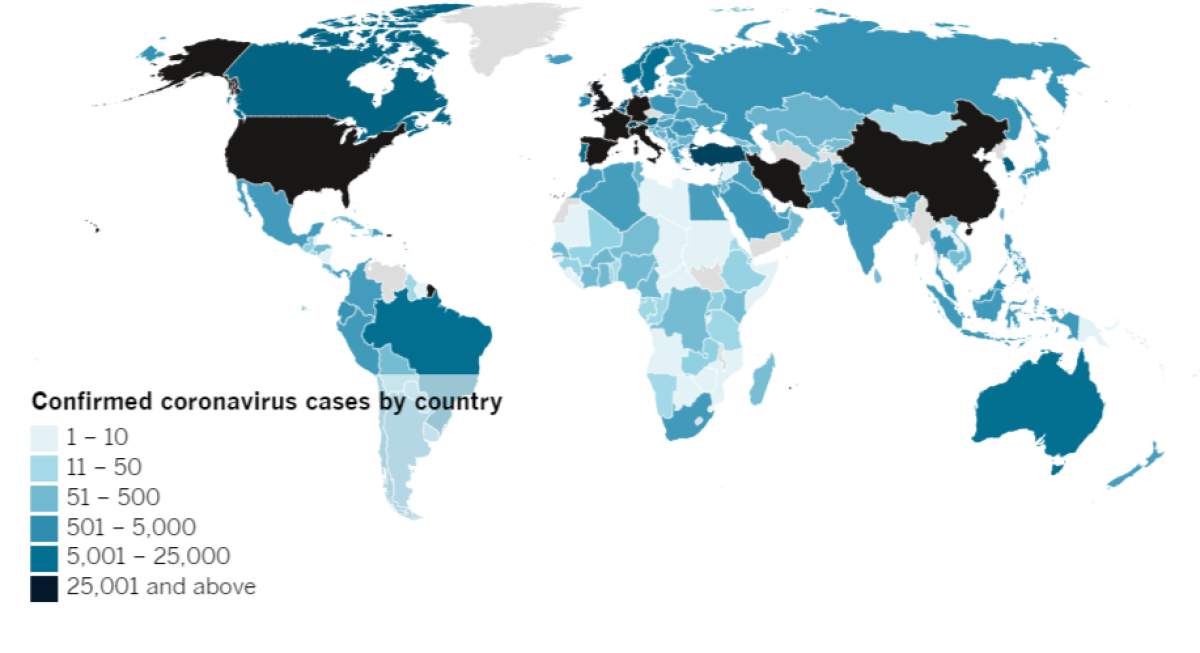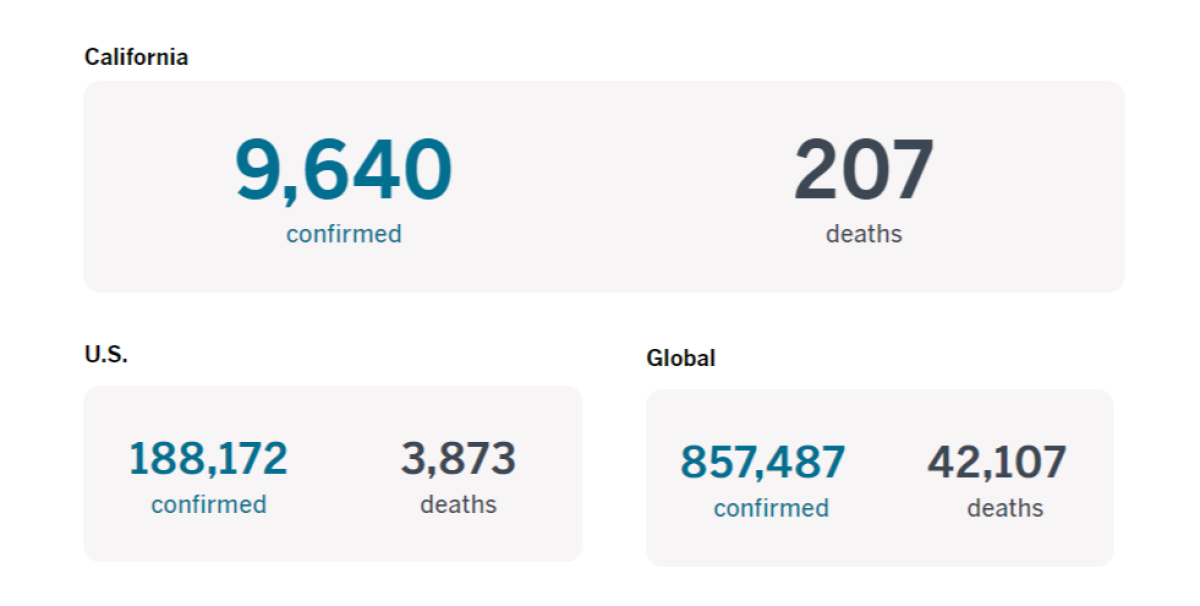Coronavirus Today: Newborns, kids and ‘quarantine families’
Good evening. I’m Diya Chacko, and it’s Wednesday, April 1. Here’s what’s happening with the coronavirus outbreak in California and beyond.
Gov. Gavin Newsom expects California’s K-12 public schools to remain closed for the rest of the academic year, indicating a lengthy period of stay-at home orders ahead. It may be necessary, however, at least according to models that predict California could face up to 5,000 deaths a week if social distancing policies intended to flatten the curve are relaxed too early. “This is not the time to relax,” said Dr. Chris Farnitano, health officer for Contra Costa County.
Such policies have expectant parents preparing to deliver with nobody but medical staff present, as hospitals in L.A. and New York ban anyone not giving birth from the obstetric triage area, leaving patients to labor alone and giving new families just minutes together. And new parents who meticulously prepared for months now find their plans mostly moot, plus complicated by the stress of worrying their babies might contract COVID-19.
Some people who don’t live with family are creating impromptu ones for quarantine company, for mutual aid as well as human contact. A small group of people does not have to be blood-related to safely practice social isolation, according to a UC San Francisco epidemiology professor. Said one member of a group that calls itself the “quarantine gang”: “If I had to choose who to go crazy with, I would rather do it with my more intentional family.”
Only days ago, economists were following President Trump’s lead in saying the U.S. economy would be back on track relatively quickly. Now, a growing number of them say the downturn will likely exceed the Great Recession of 2008-09. “This is the dilemma of the disease and of the economy. To limit and control the disease you basically have to kill the economy. It’s a trade-off,” one economist said. Federal Reserve Chairman Jerome Powell acknowledged the grim outlook but tried to be optimistic about the speed of recovery. “The virus is going to dictate the timetable here.”
California’s shelter-in-place orders exempt farm workers as essential employees. But many of the state’s workforce of 420,000 are undocumented, lack health insurance and don’t qualify for unemployment insurance or federal COVID-19 relief. Distancing requirements have made it particularly challenging to get information about the coronavirus to workers who speak indigenous languages. For those on the Central Coast, where strawberry season is about to ramp up and pay policies create an incentive to work hard and fast, it’s the worst possible time to face a health crisis.
By the numbers
Cases as of 4 p.m. PDT Wednesday:
Track the latest numbers and how they break down by county and state with our graphics.
Where is the coronavirus spreading?

Your support helps us deliver the news that matters most.
Across California
College applicants studying under dramatically unusual circumstances have a small reprieve: The University of California is eliminating the need for SAT scores and letter grades in certain classes. California State University is easing admission requirements too. The move reflects the varying degrees of success high schools and community colleges have seen in their shift to online instruction, and the cancellation of dates for tests including the SAT and ACT.
As L.A. officials worry about the spread of COVID-19 on and beyond skid row, homeless outreach workers are holding the city’s social safety net together. Wearing ski masks and spritzing themselves with alcohol between check-ins and conversations, they’re doing the crucial work of connecting homeless people with a rapidly growing list of services and resources, including emergency shelters, hotel and motel rooms, and quarantine facilities.
UCLA Health’s clinical microbiology laboratory has been on the front line of viral diagnostic testing for almost two decades. But of the viruses its director Omai Garner has encountered, the coronavirus is one of the most sinister, a Trojan horse disguising itself in symptoms of the flu. He says the next few weeks will be critical to get an accurate picture of where we are in this outbreak.
The children of a Los Angeles couple are pleading for help for their elderly parents aboard the Zaandam, a cruise ship trying to dock in Florida after being turned away from multiple ports. Four people on board have already died, and passengers are being asked to self-quarantine.
Joshua Tree National Park has now closed indefinitely to all visitors, after earlier closing campgrounds and access roads but allowing visitors on foot and by bicycle. That ended after reports of too many visitors encroaching on neighboring properties to enter the park.
How to stay safe
— Wash your hands for at least 20 seconds! Here’s a super-fun how-to video.
— Stop touching your face, and keep your phone clean.
— Watch for symptoms including fever, cough and shortness of breath (and possibly the loss of smell or taste). If you’re worried you might be infected, call your doctor or urgent care clinic before going.
— Practice social distancing, such as maintaining a 6-foot radius of personal space in public.
— Only wear a mask if circumstances warrant it. For instance, if you must be in close contact with people in public.
— Here’s how to care for someone with COVID-19, from monitoring their symptoms to preventing the virus’ spread.
How to stay sane
— Was your job affected by coronavirus? Here’s how to file for unemployment.
— Here are all the ways to stay virtually connected with your friends.
— Need groceries? Here’s how to stock up for staying home. You can also watch our video guide on YouTube.
— Visit our free games and puzzles page for daily crosswords, card games, arcade games and more.
— Here are some free resources for restaurant workers and entertainment industry professionals having trouble making ends meet.
— Advice for helping kids navigate pandemic life includes being honest about uncertainties, acknowledging their feelings and sticking to a routine. Here’s guidance from the CDC.
Around the nation and the world
Just as it’s needed to marshal a global response to the COVID-19 pandemic, the World Health Organization’s position today is arguably more fraught than at any time since the end of the Cold War. The agency must navigate tensions between the world’s two most powerful nations, and it’s encountering nationalism and, in some cases, a rejection of science fueled by populism and social media. The fractious climate could lead to new outbreaks and inequities, experts say — especially if an eventual vaccine leads to a free-for-all in which nations hoard supplies.
In Washington, nearly 9,000 employees of the Department of Homeland Security have been sidelined, with nearly 300 testing positive for COVID-19 and another 8,500 under quarantine because of possible exposure, according to an internal report obtained by The Times. In Detroit, leaders of the police department are falling to the coronavirus; about a fifth of the police force is in quarantine and more than three dozen have contracted the disease. And in Britain, Wimbledon has been canceled for the first time since World War II.
While the federal government has the authority to manage the acquisition and distribution of medical supplies in a national emergency, President Trump hasn’t yet used that power. And without a nationwide distribution plan, the competition for scarce supplies from private manufacturers threatens to deepen inequalities in the healthcare system, putting Americans in more isolated regions of the country at highest risk even as corporate support funnels masks and ventilators to high-profile institutions like Cedars-Sinai and UCLA medical centers.
“It’s frequently all about who knows someone who knows someone,” said Louisiana’s public health director. “That unfortunately means supplies aren’t always equitably distributed.”
Your questions answered
Today’s question comes from Mark Thomas, who asks: Is it safe to swim in pools?
The CDC says there is no evidence that COVID-19 can be spread to humans through pools and hot tubs themselves. Proper operation, maintenance and disinfection (e.g., with chlorine and bromine) should remove or inactivate the coronavirus that causes COVID-19.
However, there are concerns about the spread of the virus by other means in areas surrounding pools. People tend to congregate and come into contact with high-touch surfaces, particularly in enclosed spaces. There’s also the safety of lifeguards to consider.
Due to those concerns, many public pools in Southern California have now been closed.
Got a question? Our reporters covering the coronavirus outbreak want to hear from you. Email us your questions, and we’ll do our best to answer them. You can find more answers in our Frequently Asked Questions roundup, and in our morning and midday briefing.
For the most up-to-date coronavirus coverage from The Times, visit our live updates page, visit our Health section and follow us on Twitter and on Instagram.





